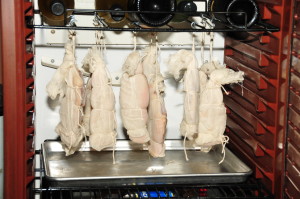 If you’ve read my latest post, you know that I made a salad with duck confit for a recent beer tasting I did with Saint Arnold Brewery. Now here’s a bit of irony. To get just duck legs (not to mention the wings, which I also used), you pay about $12 per pound, plus shipping. Or, I could buy whole duck for significantly less, which would allow me to make duck cracklins, render out fat for the confit, and have a tasty snack of “duck wangs”.
If you’ve read my latest post, you know that I made a salad with duck confit for a recent beer tasting I did with Saint Arnold Brewery. Now here’s a bit of irony. To get just duck legs (not to mention the wings, which I also used), you pay about $12 per pound, plus shipping. Or, I could buy whole duck for significantly less, which would allow me to make duck cracklins, render out fat for the confit, and have a tasty snack of “duck wangs”.
Oh, and then there were the duck breasts. Because my duck had been frozen, I didn’t want to refreeze the breasts. Because I was a bit tired, I didn’t want to cook a dinner for 10-20 people just to get rid of them. And I certainly wasn’t going to let them go to waste. That left me really only one option: preserve them.
Now it just so happens that duck confit is an old preservation method, but it seemed a shame to do that to duck breasts. Prosciutto, on the other hand seemed a very good idea, if a little daunting. As it turns out, however, making prosciutto from duck breast is fairly straightforward and quite rewarding.
Duck Breast Prosciutto
-
Kosher Salt
-
Duck Breast, with skin and fat still on
-
Spices
-
Cheese Cloth
- Butcher’s Twine
What To Do with It
Get a sheet pan and lay out the breasts. Weigh each breast. Make a notation on a sheet of paper of each breast’s weight. Rub each breast with salt. The amount of covering should be somewhere around “liberally,” which is south of generous, and north of sparingly. Place a rack in your sheet pan, and place the breasts, fat side up, uncovered, on the rack. Refrigerate for one day, uncovered.  Rinse off the salt, then pat the breasts dry.
Rinse off the salt, then pat the breasts dry.
Sprinkle on any spices you desire (or none at all). I used a combination of fennel and white pepper for some, straight Hungarian paprika for others, and finally a mix of all three. Some I also left plain. Wrap the breasts in cheese cloth, using twine to secure the cloth (tie the twine at the top, middle and bottom of the breast). With a marker, make a notation of (i) the initial weight (mine were generally between 7.5 and 9 ounces), and (ii) what spices, if any, you’ve used. Tie off with butcher’s twine and hang in a temperature-controlled environment of about 55-58 degrees Fahrenheit. My wine refrigerator worked great for this. 
 Now wait. After about 10 days, weigh each breast. You’re going for approximately 30% weight loss. At this point, you’ve probably got 4-6 more days left (more if your breasts were heavier than mine), but it doesn’t hurt to get an idea of where you stand. NOTE: although this didn’t happen to me, you may get mold on the cheese cloth. It’s OKAY! Just wipe it off. However, if you don’t wipe the mold, you’ll taint the taste of the meat: check on your prosciutto every day or so to be certain.
Now wait. After about 10 days, weigh each breast. You’re going for approximately 30% weight loss. At this point, you’ve probably got 4-6 more days left (more if your breasts were heavier than mine), but it doesn’t hurt to get an idea of where you stand. NOTE: although this didn’t happen to me, you may get mold on the cheese cloth. It’s OKAY! Just wipe it off. However, if you don’t wipe the mold, you’ll taint the taste of the meat: check on your prosciutto every day or so to be certain.
Once you achieve the desired weight loss, pull one breast and slice it to check for consistency. If it’s still pretty raw on the interior, then you need a little more curing time. If it’s turning to jerky, then you’d be well-advised to pull your other breasts out. You can serve it in just slices, on salads…almost anything you’d do with regular prosciutto.
Enjoy, e buon appetito!


